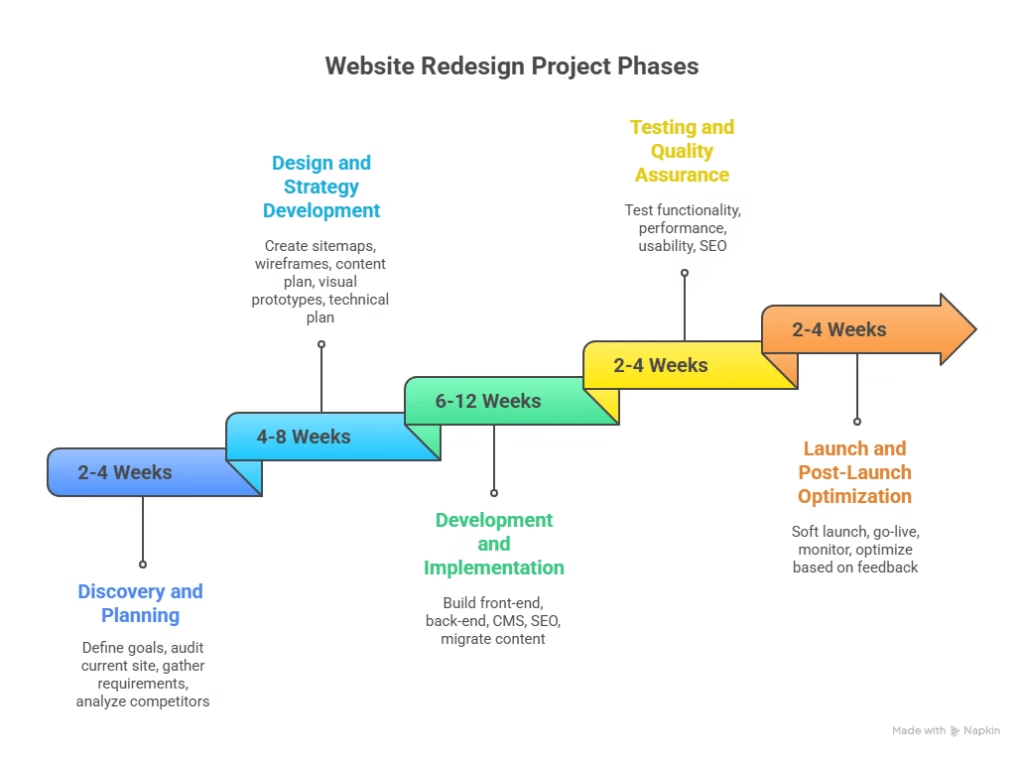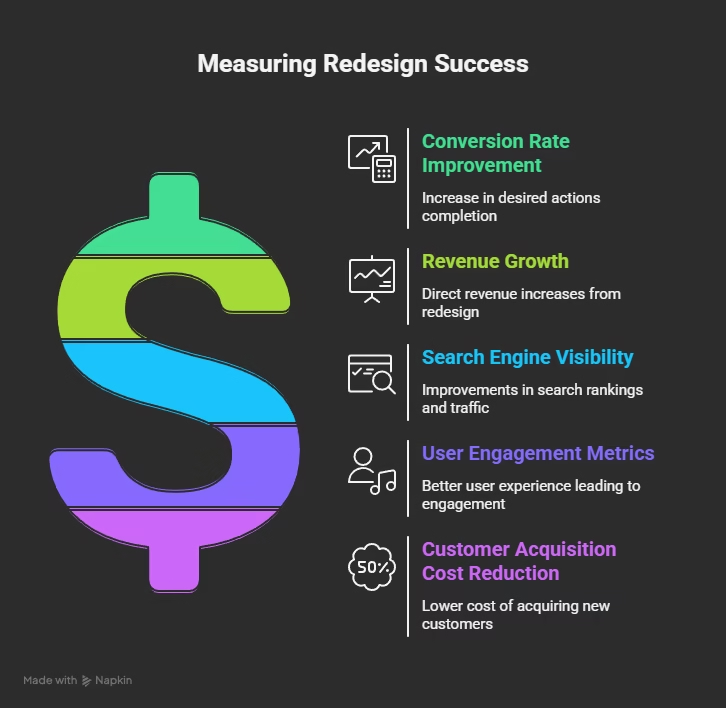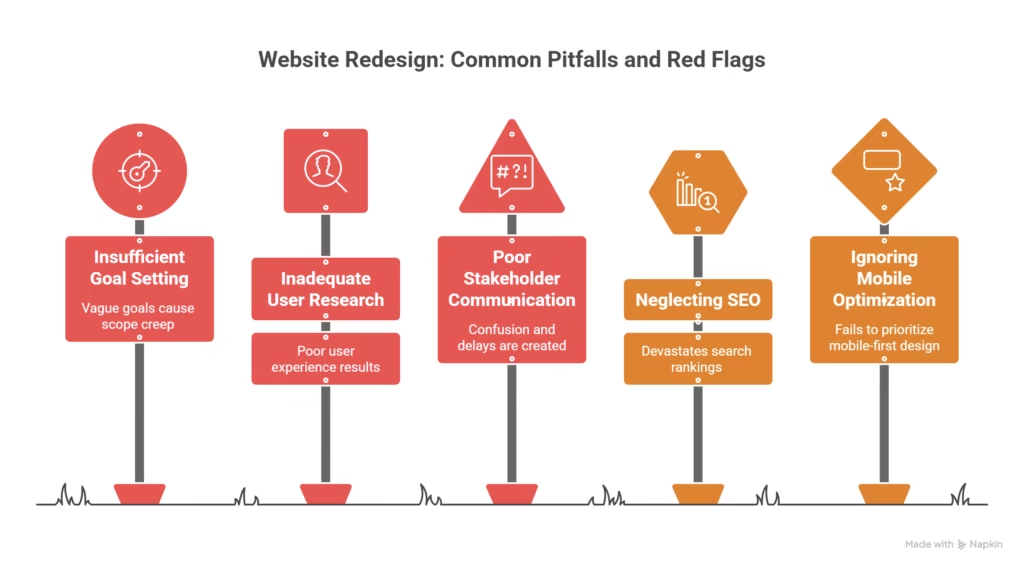A well-executed website redesign can be a game-changer for small businesses, potentially increasing conversion rates by up to 35% and driving revenue growth of 10-20%. However, without proper planning and execution, a redesign project can quickly become a costly mistake that damages your SEO rankings and alienates customers. This comprehensive guide provides small business owners with everything they need to navigate a successful website redesign project.
Table of contents
- Understanding Website Redesign: More Than Just a Visual Refresh
- Comprehensive Website Redesign Timeline
- Phase 1: Discovery and Planning (2-4 Weeks)
- Phase 2: Design and Strategy Development (4-8 Weeks)
- Phase 3: Development and Implementation (6-12 Weeks)
- Phase 4: Testing and Quality Assurance (2-4 Weeks)
- Phase 5: Launch and Post-Launch Optimization (2-4 Weeks)
- Website Redesign Cost Breakdown
- Small Business Website Redesign Costs
- Cost Factors That Impact Investment
- Calculating Return on Investment (ROI)
- Key Metrics for Measuring Redesign Success
- ROI Calculation Framework
- Common Pitfalls and Red Flags to Avoid
- Planning and Strategy Mistakes
- Technical and SEO Pitfalls
- Agency Selection Warning Signs
- Best Practices for Small Business Success
- Pre-Launch Checklist
- Post-Launch Success Strategies
- Maximizing Long-Term Value
- Future-Proofing Your Investment
Understanding Website Redesign: More Than Just a Visual Refresh
Website redesign encompasses much more than updating colors and fonts. It involves a complete transformation of your site’s visual design, user experience, functionality, content strategy, and technical infrastructure. A strategic redesign addresses outdated design elements, improves mobile responsiveness, enhances search engine optimization, and aligns your digital presence with current business goals.
Small businesses typically consider a redesign when facing declining conversion rates, poor mobile performance, outdated branding, slow loading speeds, or competitive pressure. According to research, 38% of users will stop engaging with a website if the content or layout is unattractive, making redesign a critical investment for maintaining customer engagement.
Comprehensive Website Redesign Timeline
Phase 1: Discovery and Planning (2-4 Weeks)
The foundation of any successful redesign begins with thorough research and planning. This critical phase involves:
Business Analysis and Goal Setting: Define clear, measurable objectives for your redesign. Instead of vague goals like “improve the website,” set specific targets such as “increase lead generation by 25% within six months” or “reduce bounce rate by 15%”.
Current Website Audit: Conduct a comprehensive analysis of your existing site’s performance, including analytics data, user behavior patterns, SEO performance, and technical issues. Use tools like Google Analytics, Google Search Console, and heat mapping software to gather baseline metrics.
Stakeholder Interviews and Requirements Gathering: Meet with key team members, customers, and stakeholders to understand expectations and requirements. Document user personas, customer journeys, and business processes that impact the website.
Competitive Analysis: Research competitor websites to identify industry best practices, design trends, and opportunities for differentiation. Analyze their user experience, content strategy, and conversion optimization techniques.
Phase 2: Design and Strategy Development (4-8 Weeks)
Information Architecture and Wireframing: Create sitemaps and wireframes that outline the new website structure and navigation flow. Focus on intuitive user pathways that guide visitors toward conversion goals.
Content Strategy and Creation: Develop a comprehensive content plan that addresses SEO requirements, user needs, and brand messaging. This often becomes the biggest bottleneck in redesign projects, so allocate sufficient time for content review, creation, and approval processes.
Visual Design and Prototyping: Create high-fidelity mockups and interactive prototypes that demonstrate the new design direction. Ensure designs are mobile-first and responsive across all device types.
Technical Planning: Plan the technology stack, integrations, and technical requirements for the new website. Consider content management system needs, third-party integrations, and hosting requirements.
Phase 3: Development and Implementation (6-12 Weeks)
Front-End Development: Convert approved designs into functional web pages using modern coding standards and responsive design techniques. Prioritize page speed optimization and cross-browser compatibility.
Back-End Development and CMS Integration: Build server-side functionality, database structures, and content management capabilities. Ensure the system is user-friendly for non-technical team members who will manage content post-launch.
SEO Implementation: Implement technical SEO best practices, including proper URL structure, meta tags, schema markup, and internal linking strategies. Create and implement 301 redirects to preserve existing search rankings.
Content Migration: Transfer and optimize existing content while implementing new content according to the approved strategy. Ensure all content is properly formatted and optimized for search engines.
Phase 4: Testing and Quality Assurance (2-4 Weeks)
Functionality Testing: Test all website features, forms, integrations, and interactive elements across multiple browsers and devices. Verify that all links work correctly and all pages load properly.
Performance Optimization: Test and optimize page loading speeds, image compression, and overall site performance. Use tools like Google PageSpeed Insights and GTmetrix to identify and resolve performance issues.
User Acceptance Testing: Conduct testing with actual users to identify usability issues and gather feedback. This helps ensure the new design meets user needs and expectations.
SEO Testing: Verify that all SEO elements are properly implemented, including meta tags, alt text, structured data, and XML sitemaps.
Phase 5: Launch and Post-Launch Optimization (2-4 Weeks)
Soft Launch and Final Testing: Deploy the new website to a staging environment for final review and testing. Conduct last-minute checks and resolve any remaining issues.
Go-Live and Monitoring: Launch the new website and closely monitor performance metrics, user behavior, and technical issues. Have a rollback plan ready in case critical issues arise.
Post-Launch Optimization: Monitor website performance and user feedback to identify areas for improvement. Make necessary adjustments based on real user data and analytics.

Website Redesign Cost Breakdown
Small Business Website Redesign Costs
The cost of redesigning a website for small businesses varies significantly based on complexity, features, and the team you choose to work with.
Basic Visual Redesign: $1,000 – $5,000
- Template-based design updates
- Minor functionality improvements
- Basic mobile optimization
- Limited content changes
Mid-Range Comprehensive Redesign: $5,000 – $20,000
- Custom design elements
- Enhanced user experience features
- Content management system customization
- Basic SEO optimization
- Mobile responsiveness
High-End Strategic Redesign: $20,000 – $50,000+
- Complete custom design and development
- Advanced functionality and integrations
- Comprehensive SEO strategy
- E-commerce capabilities
- Scalable architecture for growth
Cost Factors That Impact Investment
Website Size and Complexity: The number of pages and complexity of features significantly impact costs. Small websites (1-10 pages) typically cost $1,000-$5,000, while larger sites (50+ pages) can range from $15,000-$50,000+.
Design Requirements: Template-based designs are more affordable ($1,000-$5,000) compared to fully custom designs ($5,000-$20,000+). Custom design work requires more time and expertise, increasing overall project costs.
Functionality and Features: Basic websites with standard features cost less than sites requiring advanced functionality like e-commerce, custom integrations, or complex database interactions.
Content Development: Content creation and migration can add $1,000-$10,000+ to your project depending on the amount of new content needed and whether you handle it internally or hire professionals.
Team Selection: Freelancers typically charge $5,000-$30,000, agencies range from $13,000-$70,000+, while in-house teams may cost $10,000-$25,000 depending on salary and time allocation.
Calculating Return on Investment (ROI)
Key Metrics for Measuring Redesign Success
Conversion Rate Improvement: Track the percentage of visitors who complete desired actions such as making purchases, filling out contact forms, or subscribing to newsletters. A well-executed redesign can increase conversion rates by up to 35%.
Revenue Growth: Monitor direct revenue increases from improved sales, lead generation, and customer retention. Businesses typically see revenue increases of 10-20% following strategic redesigns.
Search Engine Visibility: Measure improvements in search rankings, organic traffic, and click-through rates. Enhanced SEO implementation during redesign can result in significant traffic increases, with some businesses reporting 300% improvements in organic search traffic.
User Engagement Metrics: Track bounce rate reductions, time on site improvements, and page views per session. Better user experience typically leads to improved engagement metrics.
Customer Acquisition Cost Reduction: A more effective website can reduce the cost of acquiring new customers through improved conversion rates and better user experience.

ROI Calculation Framework
To calculate website redesign ROI, use this formula:
ROI = (Revenue Increase – Redesign Investment) / Redesign Investment × 100
For example, if a $15,000 redesign generates an additional $45,000 in revenue over two years:
ROI = ($45,000 – $15,000) / $15,000 × 100 = 200%
Timeline for ROI Realization: Most businesses begin seeing returns within 3-6 months post-launch, with full ROI typically realized within 12-24 months. However, the timeline varies based on industry, competition, and implementation quality.
Common Pitfalls and Red Flags to Avoid
Planning and Strategy Mistakes
Insufficient Goal Setting: One of the most common redesign failures is launching into the project without clear, measurable objectives. Vague goals like “make it look better” lead to scope creep, budget overruns, and disappointing results.
Inadequate User Research: Designing based on internal preferences rather than user needs often results in poor user experience. Conduct thorough user research and usability testing to inform design decisions.
Poor Stakeholder Communication: Having too many decision-makers involved too late in the process creates confusion and delays. Establish clear approval processes and decision-making authority early in the project.
Technical and SEO Pitfalls
Neglecting SEO During Redesign: Changing URLs without proper 301 redirects, removing high-performing content, or failing to maintain meta tags can devastate search rankings. Create a comprehensive SEO migration plan before starting development.
Ignoring Mobile Optimization: With mobile devices generating over 60% of web traffic, failing to prioritize mobile-first design is a critical mistake. Ensure responsive design is a core requirement from the beginning.
Slow Page Loading Speeds: Heavy graphics, unoptimized images, and excessive plugins can severely impact site performance. Page speed is crucial for both user experience and SEO rankings.
Poor Content Strategy: Underestimating content development time and complexity often causes project delays. Begin content planning early and allocate sufficient resources for content creation and review.
Agency Selection Warning Signs
Lack of Discovery Questions: Agencies that don’t ask detailed questions about your business, goals, and requirements are likely to deliver generic solutions. Quality agencies invest significant time understanding your unique needs.
Unrealistic Timelines: Be wary of agencies promising extremely quick turnaround times without understanding project complexity. Quality redesigns require adequate time for planning, development, and testing.
No SEO Discussion: Agencies that don’t address SEO implications during redesign discussions may cause significant ranking losses. Ensure SEO is integrated throughout the redesign process.
Lack of Content Planning: If an agency doesn’t discuss content strategy and development requirements, expect delays and additional costs.

Best Practices for Small Business Success
Pre-Launch Checklist
SEO Preservation Strategy: Document all existing URLs, implement 301 redirects for changed pages, and maintain important on-page SEO elements. Create XML sitemaps and submit to search engines post-launch.
Content Quality Assurance: Ensure all content is proofread, properly formatted, and optimized for target keywords. Verify that contact information, pricing, and product details are accurate and up-to-date.
Performance Optimization: Test page loading speeds across different devices and internet connections. Optimize images, enable compression, and minimize resource-heavy elements.
Cross-Browser Testing: Test website functionality across major browsers including Chrome, Firefox, Safari, and Edge. Ensure consistent appearance and functionality across all platforms.
Post-Launch Success Strategies
Monitor Analytics Closely: Track website performance metrics daily for the first month post-launch. Watch for traffic drops, ranking changes, or technical issues that need immediate attention.
Gather User Feedback: Collect feedback from customers and users about their experience with the new website. Use surveys, interviews, and usability testing to identify improvement opportunities.
Continuous Optimization: Website redesign is not a one-time project but an ongoing process. Regularly review performance data and make iterative improvements based on user behavior and business needs.
SEO Monitoring: Track search rankings and organic traffic closely for at least 90 days post-launch. Address any ranking drops quickly with additional SEO optimization efforts.
Maximizing Long-Term Value
Future-Proofing Your Investment
Scalable Technology Choices: Select content management systems and hosting solutions that can grow with your business. Consider future functionality needs and integration requirements.
Content Management Training: Ensure your team understands how to maintain and update the website. Proper training reduces long-term maintenance costs and keeps content fresh.
Regular Maintenance Planning: Establish schedules for content updates, security patches, and performance monitoring. Proactive maintenance prevents costly emergency fixes and security breaches.
Analytics and Optimization Culture: Build processes for regularly reviewing website performance and making data-driven improvements. This ensures your investment continues delivering value over time.
A successful website redesign requires careful planning, realistic budgeting, and strategic execution. By following this comprehensive checklist and avoiding common pitfalls, small businesses can achieve significant returns on their website redesign investment while building a strong foundation for future digital growth. Remember that the cheapest option is rarely the best value – invest in quality planning and execution to ensure your redesign project delivers lasting business benefits.